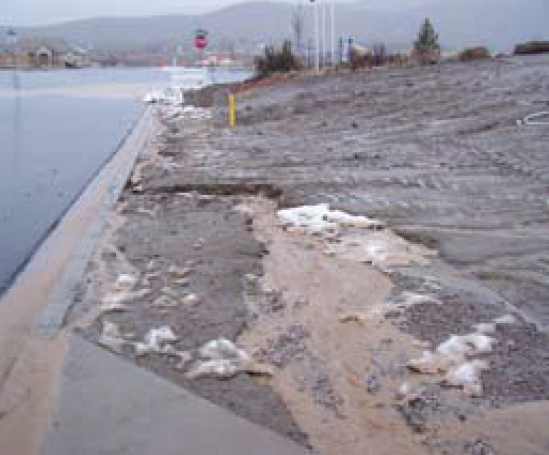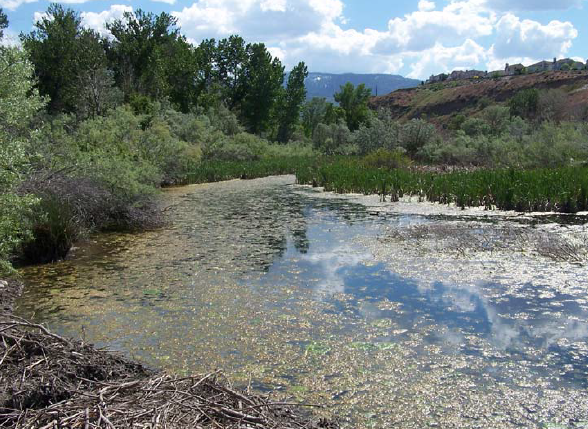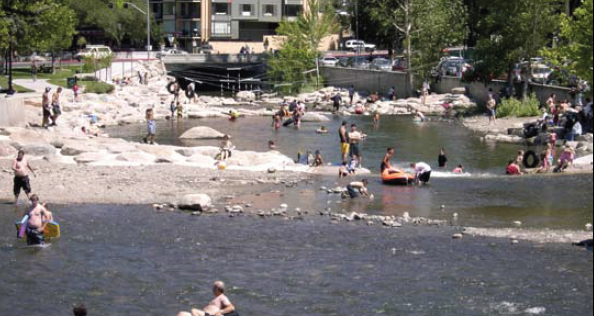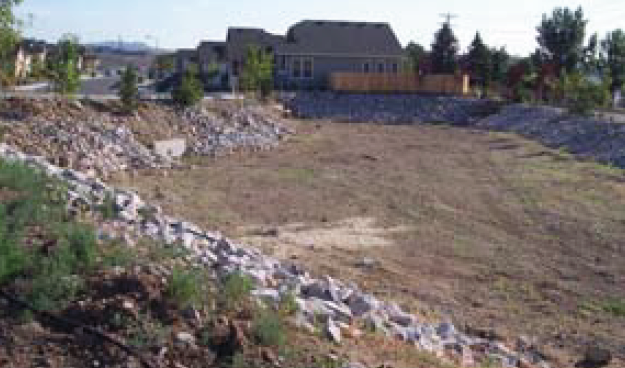Introduction
While we don’t get a lot of precipitation in northern Nevada, when it rains or when snow melts, there is often enough water to result in flow from roads, driveways, sidewalks and other impervious surfaces into the storm drain system. In addition, activities such as landscape irrigation with sprinklers, washing your car in the driveway or washing off your sidewalk often produce runoff that drains into the storm drain system.
Traditional storm drain systems are designed and constructed to convey water safely off the road to avoid flooding and traffic problems. They typically consist of a connected system of impervious concrete curbs and gutters, catch basins and underground pipes. Unfortunately, they generally are not designed to also improve runoff water quality. The water flowing off roads and other impervious surfaces picks up any pollutants, such as oil drips, trash, road sand and salts, and metals from automobile brakes. These pollutants are then carried with the stormwater and delivered, without treatment, into nearby water bodies such as the Truckee River.
As our communities grow, the total amount of impervious surface increases. This means that there is less open land available to absorb, store and treat stormwater. At the same time, we are increasingly challenged to maintain or improve water quality in local creeks and rivers so that we can continue to enjoy high-quality drinking water and opportunities to swim, fish and enjoy our waterways.
A strategy called Low Impact Development (LID) was developed to allow us to continue to grow while avoiding additional problems from polluted runoff. LID practices can also be used to treat runoff from existing developed areas.

Benefits of LID
- REDUCES and CLEANSES urban runoff
- CONSERVES water and open space
- PROTECTS waterways
- AIDS in groundwater recharge
- REDUCES traditional storm drain infrastructure
Key Elements of LID
Conservation
- Preserves native trees, vegetation and soils
- Maintains natural drainage patterns
Directing Runiff to Natural Areas
- Encourages inflation and recharge of streams, wetlands and aquifers
Small Scale Controls
- Mimics natural hydrology and processes
Customized Site Design
- Ensures each site helps protect the entire watershed
Maintenance Pollution Prevention and Education
- Reduces pollutant loads and increases efficiency and longevity
- Educates and involves the public
Source: Puget Sound Action Team
What Is Low Impact Development?
Low Impact Development, or LID, is a sustainable approach to stormwater management that minimizes impacts on waterways. LID can be integrated into “Green Design” or “Smart Growth” or similar approaches to community design. It is a flexible, site-specific, customized approach that uses a variety of site-design and pollution-prevention techniques to compensate for the impacts of land development on site hydrology and water quality.
LID is used because it is
- EFFECTIVE in reducing and treating urban runoff
- ECONOMICAL, when less infrastructure is required for LID practices than for traditional stormwater features
- SIMPLE! Most LID features are not highly engineered, expensive or elaborate
- FLEXIBLE and customized for each site
- USEFUL in achieving multiple objectives: stormwater management, landscape beautification, habitat improvement, open space connectivity, etc.
- DESIRABLE, because it adds value when the landscape features used to achieve LID goals are also aesthetically pleasing. This can increase property values.
How does LID work?
LID attempts to mimic the way rainfall, snowmelt and stormwater runoff soaked into the ground before a site was developed. Instead of conveying stormwater directly into underground pipes, it is diverted onto openspace areas, into depressed landscaping, or into other LID features, where it infiltrates. Pollutants are broken down in the soil by bacteria or taken up in plants, providing a system of natural pollutant processing. Runoff decreases when water is stored in the soil pores. Some of the water will evaporate, be used by vegetation, or infiltrate and recharge groundwater in areas where favorable site conditions exist. These effects are maximized where the site is underlain by sandy soils.
There are a number of basic practices associated with LID, from better site design to incorporating open space and cluster development, to specific technologies. All the practices attempt to achieve the following:
Mimic predevelopment site hydrology
LID attempts to reduce runoff by finding ways to infiltrate stormwater onsite, much as it did prior to development. The harvested water soaks into the ground, helping to irrigate landscaping and replenish groundwater supplies. Some of the water evaporates. This results in less runoff and fewer pollutants in stormwater, as compared with traditional site-development practices.
Minimize disturbance to the site
Nevada’s soils are easily erodible and rely on ground cover, leaf canopy and plant roots to retard erosion. The effects of soil disturbance and loss of native vegetation from grading activities during construction can last for a long time, unless revegetation is successful. Erosion of the ground surface contributes sediment to stormwater runoff. Sediment can be a source of excess nutrients and may also contain toxic chemicals and pathogens deposited from site activities. Minimizing site disturbance can minimize new inputs of these nonpoint sources of pollution.
Reduce impervious cover
Impervious cover, as noted previously, is any surface that prevents or limits the amount of water that soaks into underlying soils. Impervious surfaces include roads, driveways, sidewalks, parking lots, roofs and compacted soils. Reducing the amount of impervious surfaces when possible allows more area for onsite stormwater infiltration. There are many ways to reduce impervious cover. Instead of traditional concrete, consider permeable asphalt or concrete pavement, pavers or gravel. Minimize street widths where appropriate, allowing for emergency access. Consider installing sidewalks on one side of the road, rather than on both sides.
Minimize connected impervious cover
This LID practice seeks to interrupt the flow of stormwater runoff by disconnecting the associated impervious surfaces. This may be as simple as directing flow from driveways onto lawns, where the runoff will slow down and some will infiltrate. Pollutants will be deposited and processed naturally. Stormwater can also be captured in rain barrels or cisterns or directed via roof gutter downspouts to the vegetated areas of the yard, where the landscaping will benefit from the added water. On a larger scale, impervious cover can be disconnected by using turf areas, native landscaping or swales.
Control stormwater as close to the source as possible
By decreasing flow across impervious surfaces, fewer pollutants are transported into the storm drain system. Smallscale LID practices capture, store and treat stormwater onsite.
Preserve and restore natural landscape features
Preserving natural features, such as trees, vegetated stream buffers, native plants and natural drainage channels, helps to reduce the potential for erosion and nonpoint pollution. Where natural features cannot be preserved, recreating or incorporating landscape and drainage features that mimic natural features can help reduce runoff and process nonpoint source pollutants.
Facilitate detention and infiltration of stormwater
Detaining stormwater runoff to allow infiltration to occur can be accomplished using rain gardens and other bioretention features, vegetated swales, lawn buffers or infiltration basins. Each of these landscaping features has different benefits and design requirements, but if designed correctly, all will reduce nonpoint source pollution and erosion and improve infiltration.
Distribute small-scale practices throughout the landscape
Rather than creating one large detention basin within a development, which takes a great deal of space and is often aesthetically undesirable, small-scale practices such as rain gardens or other bioretention features can be incorporated into the landscaping of each dwelling. These multifunctional landscapes will improve water quality without loss of developable land.

Algae blooms can result from inputs of runoff contaminated with nutrients. Image by Susan Donaldson.
Literature-Reported Percent Removal Efficiency For Various Pollutants
| LID Practice |
Total Suspended Solids |
Total Phosphorous |
Total Nitrogen |
| Bioretention |
75-90% |
70-80% |
65-80% |
| Porous Pavement |
70-90% |
40-55% |
10-20% |
| Vegetated Buffers |
10-74% |
0-10% |
0-15% |
| Vegetated Swales |
60-95% |
5-45% |
15-65% |
The table above presents a summary of the literature-reported range of pollutant removal efficiencies for various LID practices. The range of removal efficiencies reflects differences in designs, variable stormwater pollutant concentrations and underlying soil properties. Source: Truckee Meadows Structural Controls Design Manual, April 2007 update.

Low Impact Development practices help protect the clarity and ecological health of our waterways. Image by Terri Svetich.
What are common LID practices?
A wide suite of different LID practices are available that can be customized to each site. Some focus on improved site design, such as open space and cluster development designs. Others are specific features that reduce and treat runoff, including bioretention features such as rain gardens and filter boxes or permeable pavements. The benefits of each practice vary, in terms of both the amount of pollutant reduction that can be expected, and the effects on peak flow volumes, volume reduction and water conservation. The table on page 6 summarizes the general benefits of various LID practices.
How much does LID cost?
LID can be very costeffective when compared to traditional development practices, particularly where soils are appropriate for infiltration. When incorporated at the planning stage, LID can reduce the cost of grading and stormwater management facilities. Additional savings can occur if road widths are minimized, alternatives to curb and gutter designs are used and other innovative design techniques are applied. In some cases, when large-scale detention basins can be eliminated, additional lots are freed for development. Lot values have increased in a number of developments that incorporated LID, due to the aesthetic value of additional open space.
Why do we need LID?
Waterways in northern Nevada watersheds are subject to regulatory limits on certain nonpoint source pollutants, including nitrogen, phosphorus, total dissolved solids and other substances. LID is one strategy that helps to decrease the amounts of these pollutants delivered to local waterways by retaining stormwater onsite, where pollutant processing can occur.
The addition of large areas of manmade impervious surfaces and the use of traditional stormwater management systems have also resulted in major changes in the volume and rate of stormwater runoff. The traditional storm drain system concentrates flows and delivers them quickly to adjacent waterways. Because the opportunity to infiltrate stormwater and store it onsite is reduced, not only do storm flows reach waterways earlier, but the volume of flow is also increased. This can result in increased erosion and flooding in areas that previously were outside the natural floodplain.
Detention and retention basins can be used to help decrease peak flows, but they typically do not infiltrate stormwater or process pollutants.
Detention, Retention or Infiltration: What’s the Difference?
Master Plans, Low Impact Development practices and Stormwater Management Manuals encourage increasing the detention, retention and infiltration of stormwater runoff. While all three terms are often used interchangeably, they are distinct practices that are used for different purposes.

Detention basins collect and slowly release stormwater. Image by Chris Conway.
Detention
Detention is the temporary storage and controlled release of stormwater to reduce peak flows from developed sites. Stormwater is detained. Most commonly, a detention basin is constructed within a development or at an offsite location. They are generally large and serve several homes or entire developments. Water flows into the basin through a large opening such as a storm drain pipe. Water exits the basin through a smaller opening, which slows the flow and reduces peak flows from the site. The peak flow rates leaving the site should be comparable to those that occurred during storm events before development took place. While not generally a design feature, some infiltration may occur through the basin floor. Some settling of suspended particles and debris will also occur. Most often, detention basins are designed so that they will empty within 24 to 48 hours after a storm has occurred. They are not practical or aesthetically pleasing on individual sites or within the home landscape. Also, detention basins typically do not reduce the increased volume of stormwater produced by manmade impervious surfaces.
Retention
Retention is the permanent storage of a portion of the stormwater produced by a developed site to allow infiltration, evaporation and/or uptake of the water by surrounding vegetation. Stormwater is retained. Retention generally occurs in a closed basin or depression of some kind. While there is no outlet from the retention basin for routine flows, an overflow structure must be designed to safely bypass stormwater flows from large storm events. To allow infiltration and prevent the long-term ponding of water, retention basins generally must be engineered to provide sufficient drainage. This may involve removal of the existing soil and subsoil and replacement with gravel, sand and/or mulch. Care must be taken not to compact the imported engineered soils. Most municipalities have limits on the length of time that water can remain in a retention basin after a single event. These requirements are intended to reduce or prevent the breeding of mosquitoes or other vermin. Retention basins can be constructed on a very small scale and are well-suited for individual home landscapes. They can also be retrofit into existing landscapes. Smallscale retention features that incorporate plant materials are also considered to be LID bioretention areas. Rain gardens are one common type of bioretention area.
Infiltration
Infiltration is the entry of stormwater into the soil profile. Stormwater is infiltrated. Under normal predevelopment conditions, infiltration occurs at varying rates depending on the type of soil and vegetation present at the site. Some infiltration of stormwater may occur in traditional earthen detention and retention basins.
However, infiltration is often limited in these basins due to compaction of the soil during construction. Large infiltration features, such as infiltration trenches or infiltration basins, are generally engineered to improve the natural infiltration. If they become clogged with silt and debris, the infiltration rate will decline. The plant roots in bioretention areas provide pathways for water to infiltrate, which helps decrease the rate of clogging.
For additional detailed planning and design information
Refer to the latest versions of the Truckee Meadows Low Impact Development Handbook and the Truckee Meadows Structural Controls Design Manual available at www.tmstormwater.com.
For a description of various Low Impact Development practices
Consult the following Fact Sheets in the “Low Impact Development in Northern Nevada” series:
LID: An Introduction, FS-09-22
Soil Considerations, FS-09-2
Rainwater Harvesting, FS-09-24
Bioretention, FS-09-25
Vegetated Swales and Buffers, FS-09-26
Green Roofs, FS-09-27
Plant Materials, FS-09-28
Porous Pavement, FS-09-29
Roadway and Parking Lot Design, FS-09-30
Maintenance, FS-09-31
For more information about LID
See:
- Low Impact Development Center, Inc., LIDC
- National Institute of Building Sciences Whole Building Design Guide, Low Impact Development Technologies, WBDG
- Urban Design Tools, Low Impact Development, LID
- U.S. Environmental Protection Agency Polluted Runoff (Nonpoint Source Pollution), Low Impact Development (LID), EPA
Technical review provided by Chris Conway, Certified Professional in Sediment and Erosion Control.
Benefits of LID Practices
| Type of LID practice |
Peak flow control |
Volume reduction |
Water quality improvement |
For more information |
| Bioretention |
|
|
|
|
| Rain garden |
X |
X |
X |
FS-09-25 |
| Tree box filter |
X |
X |
X |
FS-09-25 |
| Stormwater planter |
X |
X |
X |
FS-09-25 |
| Vegetated swale |
X |
X |
X |
FS-09-26 |
| Vegetated buffer |
X |
X |
X |
FS-09-26 |
| Green roof |
X |
X |
|
FS-09-27 |
| Porous pavement |
|
|
|
|
| Porous concrete, asphalt |
X |
X |
X |
FS-09-29 |
| Permeable pavers |
X |
X |
X |
FS-09-29 |
| Rainwater harvesting |
|
|
|
|
| Rain barrels, cisterns |
X |
X |
|
FS-09-24 |
| Site design |
|
|
|
|
| Narrow road design |
X |
X |
|
FS-09-30 |
| Downspout routed1 |
X |
X |
|
FS-09-24 |
| Tree planting |
X |
X |
|
FS-09-25, FS-09-28 |
1When downspout is routed to landscaping
Donaldson, S. and Hefner, M.
2009,
Low Impact Development in Northern Nevada: An Introduction,
Extension | University of Nevada, Reno, FS-09-22


